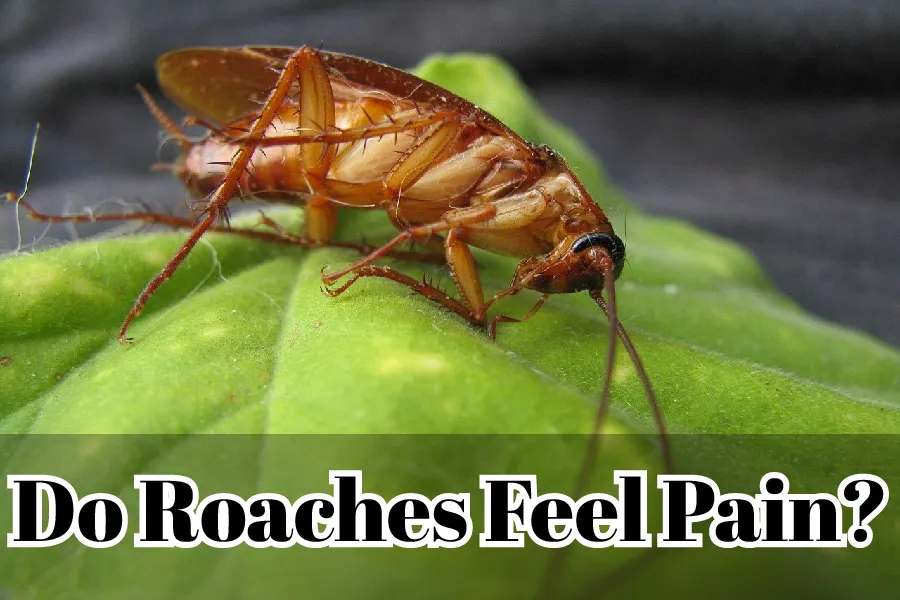Do roaches feel pain? The question seems simple enough to answer, but it’s quite complex. While they may not have the same perceptions of pain that humans do, many people believe they feel some form of pain.
But is this true? Do cockroaches have the same senses as humans? Are roaches even capable of feeling pain, or are they merely reacting to certain stimuli? The answer depends on who you ask and what you define as pain in the first place.
Here are some facts to help you understand this pesky pest better.
Do Roaches Feel Pain?
Roaches do not feel pain. These six-legged insects don’t have any neural mechanisms (neurons and receptors) necessary for pain perception in humans and other animals and will not react to harmful stimuli.
Roaches are invertebrates, which means they don’t have a spinal cord or brain – to pin the label “consciousness.” Instead, they have a gangly nervous system that connects various parts of their body and transmits impulses to and from their brains.
When you touch or spray a cockroach, it will wriggle and spin around, which may lead you to believe it’s in pain. However, this is only a physiological pattern that lacks pain’s grief, misery, and agony.
Pain In Invertebrates
Readers are often curious about the feelings invertebrates experience. Pain is a notoriously difficult subject to study in animals, but some scientists have been trying to answer this question for decades.
Pain is a multi-dimensional experience, and different organisms may feel pain differently. Pain is an unpleasant feeling often caused by intense or damaging stimuli.
The sensation of pain is mediated by several different neural mechanisms that ultimately transmit the information to the brain for further processing. You can also describe the pain as a throbbing, searing, or like an electric shock.
Pain behavior is a complex phenomenon that involves a series of physiological states and behavioral responses related to an adverse stimulus (i.e., noxious stimuli).
The nociceptors, or receptors that detect noxious stimuli are specific to vertebrates and are absent in invertebrates.
Thus suggesting that although they might not perceive pain, they still can sense noxious stimuli.
Scientists have started to uncover molecular and physiological mechanisms of pain in invertebrates and are now studying which stimuli trigger the feeling.
The following are a few criteria that may indicate a potential to experience pain:
- have complex sensory systems, including nociceptors and pain receptors.
- Exhibit nocifensive behaviors, such as rubbing or flicking their limbs when encountering noxious stimuli.
- Exhibit long-lasting behavioral aversion to noxious stimuli. For example, following exposure to hot chili pepper solution, they show increased wariness towards the conditioned stimulus (capsaicin) for hours or days later.
- Exhibit behavioral changes resulting from nerve injury or damage, affecting their perception of noxious stimuli.
- Have a natural aversion to harmful stimuli.
Nociceptors: What Are They?
A nociceptor is a sensory receptor that detects potential tissue damage. The majority of noxious stimuli are perceived by nociceptors, which are particularly sensitive to pressure, mechanical force, or extremes in temperature.
Upon stimulation, these free nerve endings release neuropeptides that induce pain. A normal level of background ‘‘somatic’’ pain is caused by the activation of A-beta mechanoreceptors.
They send signals along the peripheral nerves to the spinal cord and brain, perceived as pain. Nociceptors are responsible for detecting stimuli that damage tissue and respond in ways that are often considered involuntary: they cause us to withdraw our hands from hot stoves.
Nociceptors have been found in many animal species. For example, when a human is burned by a flame or cut by a knife, the receptors send a message to the brain and spinal cord, responding by activating neurons that cause pain.
Nociceptors are also responsible for signaling when tissue is being damaged. The destruction of these cells may lead to less sensitivity to pain.
This would be particularly important in injury-related situations, such as severe burns or wounds where sensation would be harmful and potentially life-threatening.
In addition to detecting physical damage, nociceptors can detect chemicals that signal damage.
These include cytokines released by injured cells and stimulate the immune system to respond to wounds.
These chemicals would signal to the brain that tissue is being damaged, increasing pain.
Can Cockroaches Live Without A Head?
Cockroaches are one of the most well-known pests and have been a source of disgust for humans for centuries. Despite its notoriety, the roach is a resilient critter that can survive decapitation.
The headless cockroach can stay alive and even move around for several hours, as long as its nervous system remains intact. The roach will die if you sever its head completely from its body.
Cockroaches can live up to a week without their heads! They’re able to do this because of a highly sophisticated nervous system that allows them to function without any head.
The roach has a brain located in its head, and the brain contains most of the neurons (nerve cells) in the body.
When the cockroach loses its head, the remaining tissue forms a new brain inside the thorax (the middle section containing the legs and wings).
This new “brain” can regulate heart rate, digestion, and reflexes. When decapitated, the cockroach will sometimes twitch and move its legs. This is not a reflex but an involuntary action initiated by the remaining body tissue.
Why Do Cockroaches Die On Their Backs?
Cockroaches have an interesting biological characteristic: they die faster and more often on their backs than on their feet. The reasons for this are the subject of much speculation, some more convincing than others.
Scientists have conducted plenty of experiments to determine why this happens, but most of these experiments are not conclusive because they don’t consider the roach’s natural environment.
If you want to understand why cockroaches die on their backs, you have to look at them as they would exist in nature, not just in a lab.
Their legs are too short of flipping themselves over, and they don’t have any other body parts that can help them get up again.
An evolutionary theory speculates that cockroaches evolved to hold their breath for long periods (40 minutes), so they could escape predators by hiding beneath the ground.
Over time, this trait was passed down to generations and developed into a “death grip response” when they sense danger. The cockroach tenses up their leg muscles and holds their breath until the threat is gone.
Can Cockroaches Play Dead?
Yes, it is true. Or, at least it’s true in a general sense. Cockroaches will play dead when threatened, but not always in the way you might expect.
When most people face danger, they either fight or flee. Cockroaches will sometimes play dead. This is called “tonic immobility,” and it is a behavior that many insects exhibit when threatened or injured.
Interestingly, only about 20% of individuals exhibit tonic immobility in response to being squeezed. The other 80% will attempt to run away or fight back when provoked.
Therefore, it suggests that the roach’s ability to play dead has evolved as an adaptation to life on Earth, where they have to deal with threats from all manner of creatures, from cats to raccoons.
Tonic immobility is a naturally occurring phenomenon in many animals. It has been observed in several frogs, birds, and even mammals.
Next time you see a cockroach on the floor, take a second to think about how this hardy little insect has survived for hundreds of millions of years!
How Do Roaches Procreate?
The mating season for Periplaneta americana, the American cockroach, begins in the spring and peaks during summer.
Male cockroaches produce pheromones to attract females for mating. Females can store sperm from multiple matings and will mate with multiple males.
After mating, females deposit eggs into oothecae (egg cases). Each egg case is made of a gelatinous material and contains a nutritional material for the embryos. The eggs hatch after about a month(around 6-8 weeks), and nymphs emerge.
Female cockroaches lay oothecae which contain 16-20 eggs. Each egg’s location is in an individual compartment within the ootheca.
A female will produce between one and four oothecae during her lifetime, depending on environmental conditions such as temperature and food availability. Each egg develops into a nymph, molt several times, and eventually becomes an adult.
Cockroaches have several life stages: egg, nymph, and adult. Nymphs molt four times before becoming adults.
Conclusion
Roaches do not feel pain; they can sense it but have no emotions to associate with it.
They have existed for millions of years and will continue to be a part of the ecosystem for many more. While it’s important not to underestimate cockroaches, there are some things you can do to keep them from becoming an issue in your home.
Keep reading our blog for other helpful tips on how to get rid of roaches and prevent them from coming back.
 Being Human
Being Human





